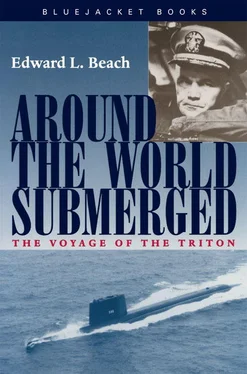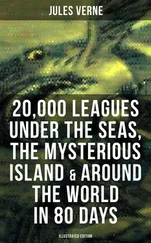Flying from our highest periscope will be a rather old and slightly weather-beaten set of colors, and thereby hangs the very personal story which, already partly told in these pages, must now be completed.
In 1916, my father was Commanding Officer of the armored cruiser Memphis [ex-Tennessee] which, he used to say, was the most responsive ship, the best trained and the easiest handled, of any he had ever served in. On August 29th of that year, lying at anchor at Santo Domingo, capital of the Dominican Republic, while pacing the quarterdeck with the skipper of the tiny gunboat Castine, who had come to call, Father noticed a heavy surf along the shore. A look to seaward brought him up with a start; he ordered Commander Bennett back to his ship and directed that both ships be made immediately ready to go to sea. Hurriedly, he sent a message directing the baseball team, then due to return from practice, to stay ashore. Two of the three boats received the message and did indeed wait, but the third either did not see the signal or failed to understand it, for on it came.
Forty minutes later, a tidal wave swept completely over the top of the Memphis, swamped the bridge, inundated the entire topsides of the ship. Memphis had almost, but not quite, got steam to her engines. [Castine, a much smaller ship, did in fact get up steam in time.] Father’s anchor chains [all three anchors, in desperation, were down] stretched, then snapped; Memphis was swept from her berth, and within half an hour she crashed ashore in 12 feet of water, a total wreck. Until recently, the hulk could still be seen there, placarded with billboard advertisements.
Father survived the catastrophe, although a number of people who were standing on the bridge with him were swept overboard and lost. Several were killed by flying debris below decks, or by burst steam lines; and he watched helplessly as the boat with the baseball party rolled over and over in the gigantic surf. Thirty-three sailors, and a part of Father, died that day.
Not long ago I received a letter from an ex-Navy man who wanted to know, since I bore the same name, if I were related to his old skipper in the Memphis. I responded that I was indeed—and after some additional correspondence it developed that Stanley P. Moran of Wilmington, Delaware, one of Memphis’ quartermasters, had rescued the ensign which flew over Memphis that disastrous day.
Sam Worth of Cleveland, Ohio, its present guardian, had no idea, last February, why I suddenly had such need of his cherished flag, but he sent it to me by special delivery immediately upon receipt of my urgent letter. Soon he and Stanley Moran and all the remaining survivors of the Memphis catastrophe will know why I wanted it; for when Triton enters the Thames River on May 11, next, this same flag will be flying once again, probably for the last time, over a mighty US man-of-war.
The Navy is composed of ships, and men, and long-held traditions—all melded together in dedicated service to their country. It is more fitting that the last sight graced by this old flag should be one of gladness and success, rather than disaster and death.
Father has been gone more than 16 years, but this is something I’ve always wanted to do for him.
Still from the Log:
Tuesday, 10 May 1960 0430 Surfaced, having been submerged exactly 83 days and 10 hours [figured on twenty-four-hour days], and travelled 36,014 miles.
The rendezvous is still several hours hence, but we are now approaching the shallow water off the east coast of the United States, where Triton cannot venture without her fathometer. The long voyage is over.
The men of the Triton believe her long undersea voyage has accomplished something of value for our country. The sea may yet hold the key to the salvation of man and of his civilization, for it is the connecting link between all the diverse parts of the world. The sea has given us a means of waging war, but even more, it has given us an avenue to hold the peace. Never have wars been fought for the sole purpose of controlling or annexing the sea. The limitless sea, like the air and space above the air, is free to all who would use it peacefully, in consonance with the principles of international humanity.
That the world may better understand this, the Navy directed a submerged retrace of Ferdinand Magellan’s historic circumnavigation. The honor of doing it fell to Triton, but it has been a national accomplishment; for the power which propels our ship, the genius which designed her, the thousands and hundreds of thousands who labored, each at his own métier, in all parts of the country, to build her safe, strong, self-reliant, are America. Triton, a unit of their Navy, pridefully and respectfully dedicates this voyage to the people of the United States.
Our Log ended at sea, ready for pickup on the morning of the tenth of May, its last entry written several hours in advance of the event in order to have it properly typed and ready upon arrival. Tying up loose ends took until the small hours of the morning, and I finally turned in, exhausted, to get a few hours of sleep before the rendezvous. It fell to Will Adams, therefore, to have the honor of bringing Triton back to the surface just before dawn. I was awakened by the jolt of high-pressure air roaring into her twenty-two main ballast tanks.
As we slowly steered toward the appointed place off Rehoboth Beach, leaden gray skies gradually replaced the dark overcast of night. With the day came our first visitor, a curious sea bird winging in graceful circles and figure eights overhead, swooping in civilized instinct low over our wake for the bits of garbage which he and his fellows have long learned to associate with ships at sea. Land itself was not to be seen, and we might as well have been in the middle of the Atlantic, or in the Pacific, half a world away. But this romantic notion lasted only a short time. Soon our sea bird was joined by another type of bird, a land variety with wheels, a fixed wing, and a propeller glinting light from its nose. Behaving like its handsome wild cousin, the small plane flew low to pass by our side at close range. We waved vigorously at its occupants, who could clearly be seen waving in return. One of them, holding a large camera, appeared to be taking pictures.
Soon, another small plane joined the first one, and then a third. And speeding out of the west, where the shadows of early morning were yet visible in the horizon haze, the bows of a speedboat pushed a white mustache of water in front of it. It looked familiar as it came closer, and in a few minutes, as it turned broadside, I remembered where I had last seen this powerful craft, or one like it. An experimental postwar PT boat, it had been based at the old Washington Navy Yard for the past several years. The Officer-in-Charge was known as a person whose knowledge of the Potomac River and ability to handle small craft were second to none in the Navy. I wondered if it was indeed the same boat, if Walter Slye had been sent to meet us, and indeed whether or not he still held the post. Binocular inspection brought no answer while the boat was still bows on, but when it sheared off and presented its silhouette, the interior of the cockpit became visible and revealed Slye himself, uniform cap, as always, perched squarely on the top of his head. With delight, I waved my cap to him, and he waved back.
It seemed only a few minutes, though it must have been some time later, that one of the lookouts reported the approach of two helicopters lumbering toward us from the hidden continent to the west. Radioed instructions had prepared us; I went on deck with George Sawyer and the helicopter landing party. When one of the machines hovered over our deck aft to lower a strange inverted mushroom-shaped object to us, I set my hat firmly on my head, ignored the fluttering roar and wind from the whirling blades, and seated myself on it, straddling the center stalk and wrapping my arms around it. To my surprise, the mushroom, which had looked like metal of some kind, felt like foam rubber and was not a bit uncomfortable. I looked down. George was already many feet below me, holding up a signal flag, and Triton was receding at a rapid pace. There was suddenly something alongside me—the fuselage of the helicopter and a yawning door into the interior. Friendly faces stared at me and friendly arms reached out to steady the mushroom seat.
Читать дальше












